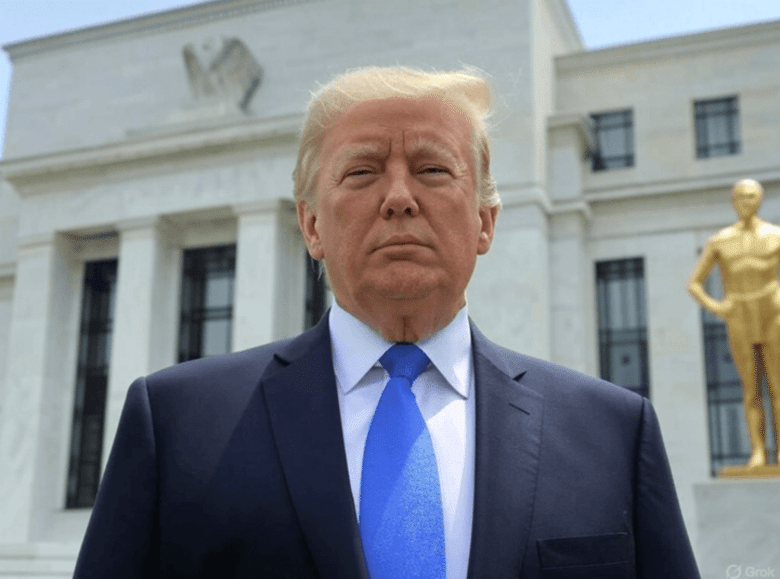Did you catch Warren Buffett’s retirement warning?
“Obviously, we wouldn’t want to be owning anything that we thought was in a currency that was really going to hell,” Buffett said.
“There could be things that happen in the US that make us want to own a lot of other currencies.”
Here’s a 10-second snapshot before we dig into this week’s missive…
|
It’s no secret that the goal of Project 2025 is to reshape the structure of the U.S. government.
But most people have no idea just how rapidly the 900+ page Project 2025 playbook is being made law—or what’s planned for the next few months.
In just 91 days, 42% of Project 2025’s recommendations have been implemented.

In other words, the vast majority of this plan is likely to become reality, including many things that previously seemed unthinkable.
Coming up very quickly on the Project 2025 agenda is something that has long been beyond criticized by experts: a reversal of President Nixon’s 1971 repeal of the gold standard.
Chapter 24 of the playbook outlines specific plans to make two dramatic moves:
- Rein in the Federal Reserve (you’ve already seen this begin to unfold).
- Bring the gold standard back (this process is already beginning), possibly on the way to “free banking.”
This has nothing to do with what the “expert” economists say.
Throw out the usual rule book for what’s possible. If the will of the people in charge is a return to the gold standard, it has a good shot at becoming the law of the land.
Back to the Future of Currency
Of course, people with something to lose returning to the gold standard are going to fight it tooth and nail. People like current Fed Chair Jay Powell:
Former Fed Chairman Alan Greenspan after he retired, sing a very different tune:
And before he rose to the Federal Reserve:
Greenspan’s fears have come to pass over the past half century.
Prior to the “Nixon Shock,” the U.S. saw several iterations of the gold standard—in fact, this is the longest it’s gone without a major currency iteration.

As the U.S. has slowly shifted away from a true gold standard, inflation has risen—and growth has declined.

If the growth from the ‘70s was maintained through today, median income would be $40k higher than it is. And the economy would be 20% larger—or ~$5 trillion.
With a single stroke of a Sharpie, the current administration could achieve several of its most desired and difficult objectives:
- Limit the amount that the money supply can grow—reining in government spending.
- Curb inflation, the great enemy of the incumbent.
- Completely neuter the Federal Reserve.
A return to the gold standard has support at the highest levels.
The Color of Winning
Because there’s nothing Trump likes more than gold.
He himself made a 400% return by investing in gold in the ‘70s, calling it “easier than the construction business.”
But he doesn’t just love gold. He actively agrees with Project 2025—and sees the gold standard as positive for the U.S. Here he is in separate interviews:
“We used to have a very, very solid country because it was based on a gold standard.
Bringing back the gold standard … boy, would it be wonderful. We’d have a standard on which to base our money.”
The current leaders have uncovered a pathway to make that true.
The M.O. of the current administration is to find a loophole—some arcane, barely relevant historical precedent—and exploit it. And they’ve found just the one.
In his address, President Nixon indicated that the U.S. would not permanently go off the gold standard:
According to former Trump chief strategist Steve Bannon, that order is “going to be reviewed strongly in the second term… Talk about getting rid of the Fed, maybe you start with converting back to gold.”
Roosevelt and Nixon, who both helped take the U.S. off the gold standard, used executive orders and proclamations to do so. The current administration feels that it may do the same to bring it back.
The roadmap to get there exists.
Any route taken to return to the gold standard would have an immense impact on demand for and the price of gold.
Going for the (Price of) Gold
Under a return to the gold standard, what would the new price of gold be?
The final few iterations of the gold standard in the U.S. used a fractional reserve system, just like banks do with money. So the answer must consider what percentage is used for that fractional reserve system.
Skip the next two lines if you’re not a numbers person…
There are 261M ounces of gold in U.S. reserves.
At $3,400/oz, that’s worth about $900B.
There is about $19T in M1 money supply outstanding, which means current reserves would back 4.8% of the money supply.
- To back just 10% of the M1 money supply would require gold to double in value.
The graph below shows the approximate prices of gold required at every level of fractional reserve backing:

At 50% backing, gold would have to rise 10x from its current level.
The alternative is for current reserves to grow.
The U.S. would need more than 2 billion ounces to get to 100% backing at current gold values—or about 1/3 of all gold ever mined.
That would have a similar effect on the price of gold.
But the math is not important. What’s important is this:
- Any effort to return to the gold standard is going to send gold through the roof—and those efforts are already here.
The groundwork is already being laid. And investors will seek refuge in gold anyway, as they always have.
Regards,
Marin Katusa
P.S. one of my major gold holdings is up 60% in the last two months. And I think it has much, much further to run. To get the name of the company, become a subscriber to Katusa’s Resource Opportunities today.
Details and Disclosures
Investing can have large potential rewards, but it can also have large potential risks. You must be aware of the risks and be willing to accept them in order to invest in financial instruments, including stocks, options, and futures. Katusa Research makes every best effort in adhering to publishing exemptions and securities laws. By reading this, you agree to all of the following: You understand this to be an expression of opinions and NOT professional advice. You are solely responsible for the use of any content and hold Katusa Research, and all partners, members, and affiliates harmless in any event or claim. If you purchase anything through a link in this email, you should assume that we have an affiliate relationship with the company providing the product or service that you purchase, and that we will be paid in some way. We recommend that you do your own independent research before purchasing anything.



